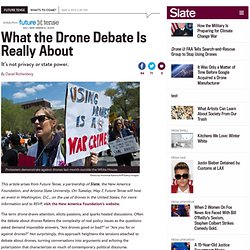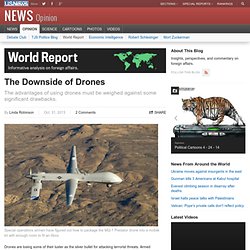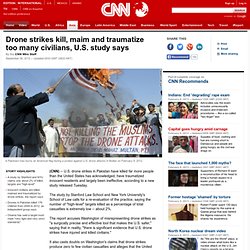

Call for Articles: Defining Global Norms on Drone Policy. In cooperation with the Politisch-Militärische Gesellschaft (pmg) e.V., Atlantic Community is launching its fifth Theme Week in 2013, addressing the international debate on whether we should, or how to, utilize drones for military purposes.

We cordially invite you to submit your opinion and join in our discussion on how the transatlantic partners can define globally recognizable norms for deploying drones in and outside of official war zones. What steps need to be taken in order to shape these norms, and ultimately, what form should these norms take? As with almost every technical innovation, the advantages and disadvantages of drones are highly contested, especially when used as combat drones. However, since the first US lethal drone strike in Afghanistan in October 2001, no less than 87 countries have allegedly used drones militarily. Whereas some states deploy drones simply for surveillance operations, others, like Germany, legally reject the use of targeted killing. Drones in the United States: What the debate is really about. Photo by Nicholas Kamm/AFP/Getty Images This article arises from Future Tense, a partnership of Slate, the New America Foundation, and Arizona State University.

On Tuesday, May 7, Future Tense will host an event in Washington, D.C., on the use of drones in the United States. Inside Pakistan's drone country. 3 October 2012Last updated at 19:42 ET By Ahmed Wali Mujeeb BBC News, Waziristan.

The Honest Truth – Drones - Honest Truth / That's Life / The Sunday Post. The controversial Unmanned Aerial Vehicles are now a permanent part of the UK and US military arsenal.

Last week, the deputy leader of the Taliban — Waliur Rehman — was killed in a strike by a US military drone. It’s another victory for those who support the use of the unmanned war machines. However four other people were killed in the attack — and critics say drones are unsafe. They may look like something from a science fiction movie, but the UK and US military rely on flying drones every day to carry out dangerous operations in warzones, like Afghanistan. As well as being flying spy cameras, these unmanned vehicles often pack sophisticated weaponry. What is a drone? Drone Strikes Aren't Always the Most Effective Counterterrorism Measure - World Report.
Special operations airmen have figured out how to package the MQ-1 Predator drone into a mobile kit with enough room to fit an Xbox.

Drones are losing some of their luster as the silver bullet for attacking terrorist threats. Armed unmanned aerial vehicles clearly will have a role to play in our counterterrorist policy, but their disadvantages compared to other tactics are coming into focus thanks to a healthy debate. While drones offer the advantage of minimizing risk to U.S. servicemen who might otherwise be put on the ground in a combat role, that must be weighed against some significant drawbacks. The pros and cons of drone warfare. When two packed passenger planes slammed into the tallest buildings in New York on September 11 the world changed.

A ‘coalition of the willing’ was formed, a ‘war on terror’ started and Australian troops hit the ground in Afghanistan and Iraq. Why Drones Work: The Case for Washington's Weapon of Choice. Despite President Barack Obama’s recent call to reduce the United States’ reliance on drones, they will likely remain his administration’s weapon of choice.

Whereas President George W. Bush oversaw fewer than 50 drone strikes during his tenure, Obama has signed off on over 400 of them in the last four years, making the program the centerpiece of U.S. counterterrorism strategy. The drones have done their job remarkably well: by killing key leaders and denying terrorists sanctuaries in Pakistan, Yemen, and, to a lesser degree, Somalia, drones have devastated al Qaeda and associated anti-American militant groups.
And they have done so at little financial cost, at no risk to U.S. forces, and with fewer civilian casualties than many alternative methods would have caused. Critics, however, remain skeptical. Drones: the good, the bad and the ugly. There’s a lot of talk about drones recently, some of it reasoned but most of it not.

Drone strikes kill, maim and traumatize too many civilians, U.S. study says. A Pakistani man burns an American flag during a protest against U.S. drone attacks in Multan on February 9, 2012.

A study by Stanford and NYU claims only about 2% of killed targets are "high-level"Innocent civilians are killed, maimed and traumatized by drone strikes, the report saysDrones in Pakistan killed 176 children from 2004 to 2012, an independent group saysObama has said a target must meet "very tight and very strict standards" (CNN) -- U.S. drone strikes in Pakistan have killed far more people than the United States has acknowledged, have traumatized innocent residents and largely been ineffective, according to a new study released Tuesday. The study by Stanford Law School and New York University's School of Law calls for a re-evaluation of the practice, saying the number of "high-level" targets killed as a percentage of total casualties is extremely low -- about 2%. Obama reflects on drone warfare use. Great Debate: Drone Warfare. This is the twelfth post in the TMP series “The Great Debate,” a round-up of opinions from experts, officials, professors, and students on pressing questions in international affairs.

Targeted killings using unmanned aerial vehicles (UAVs) have become a common in the United States’ counterterrorism efforts, particularly in countries like Yemen, Pakistan and Somalia. Although the U.S. government quietly acknowledges the use of drones to kill suspected terrorists, reports suggest that nearly 5,000 people have lost their lives in these strikes. Among those killed was American-born Muslim cleric Anwar al-Awlaki, a major al-Qaeda propagandist, and his 16-year-old American-born son. Disadvantages - Military Air Robots by Tori. While there are many advantages to having this technology as a part of a military, there are also disadvantages. There are the expenses of buying and operating the machines, unexpected malfunctions and things to go wrong while in the air, and hackers that can get into the drone’s hardware. The losers here consist of militaries that do not have UAVs and pilots that want to do the missions the drones are taking over.
Military spending may increase with the need for newer and more robots. Initially it may seem that these aircrafts are not expensive – as far as aircrafts go – because the initial cost is not as high as manned aircrafts. US Drones Have Killed Up to 900 Civilians in Pakistan. Predator drone via Wikimedia Commons Amnesty International just published the results of detailed field research on nine of 45 reported drone strikes that occurred between January 2012 and August 2013 in the Pakistan's North Waziristan region—and found that the US might be responsible for up to 900 civilian deaths. The report is a microcosm of a program that has been on-going since the start of Bush's second term, and has grown under the Obama administration.
“According to NGO and Pakistan government sources the USA has launched some 330 to 374 drone strikes in Pakistan between 2004 and September 2013,” which resulted in estimates of between “400 and 900 civilians [having] been killed in these attacks and at least 600 people seriously injured,” the report stated. via Amnesty International. Everything We Know So Far About Drone Strikes.
A U.S. Air Force MQ-1 Predator unmanned aerial vehicle. The U.S. is conducting drone strikes in in at least three countries beyond Iraq and Afghanistan. (U.S. Air Force photo by Master Sgt. Stanley Thompson) Drones killed 67 civilians in five years: Pakistan. Pakistanis killed in suspected drone strike - Central & South Asia.
At least five people have been killed in a suspected US drone attack on an Islamic seminary in Pakistan's northwestern region of Khyber Pakhtunkhwa. Fareed Khan, a local police officer, said the unmanned aircraft fired at least three rockets at the madrasa in the Hangu district, killing two teachers and three students just before sunrise on Thursday. The identities of those killed on Thursday were not immediately clear. An intelligence source told Reuters news agency separately that Sirajuddin Haqqani, leader of the Afghan Taliban-linked Haqqani network, was spotted at the seminary two days earlier.
Pakistan publicly opposes US drone strikes, saying they kill too many civilians and violate its sovereignty, although in private officials admit that the government broadly supports them.